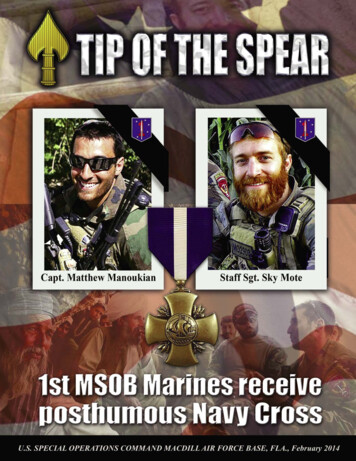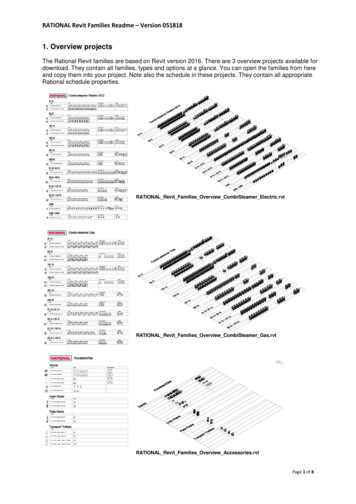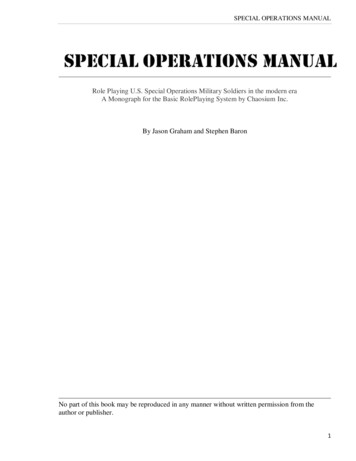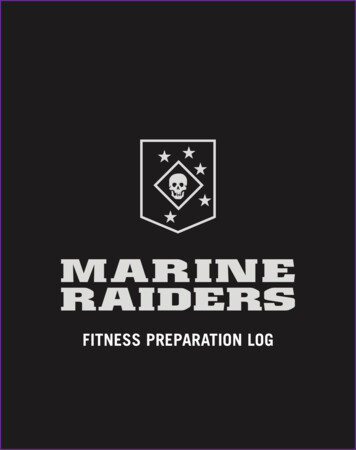
Transcription
Two MARSOC families receive the Navy Crossfor their sons’ heroic actions . 30Tip of the SpearAdm. William H. McRavenCommander, USSOCOMCSM Chris FarisCommand Sergeant MajorThis is a U.S. Special Operations Command publication. Contents are notnecessarily the official views of, or endorsed by, the U.S. Government,Department of Defense or USSOCOM. The content is edited, prepared andprovided by the USSOCOM Public Affairs Office, 7701 Tampa Point Blvd.,MacDill AFB, Fla., 33621, phone (813) 826-4600, DSN 299-4600. Anelectronic copy can be found at www.socom.mil. E-mail the editor viaunclassified network at public.affairs@socom.mil. The editor of the Tip ofthe Spear reserves the right to edit all copy presented for publication.Ken McGrawPublic Affairs DirectorMarine Corps Master Sgt. F. B. ZimmermanStaff NCOIC, Command InformationAir Force Tech. Sgt. Heather KellyStaff Writer/PhotographerMike BottomsManaging EditorAir Force Master Sgt. Larry W. Carpenter, Jr.Staff Writer/PhotographerAir Force Tech. Sgt. Angelita LawrenceStaff Writer/Photographer(Cover) Marine Corps Staff Sgt. Sky Mote and Capt. Matthew Manoukian, whose families were awarded the Navy Cross,posthumously, for their heroic and selfless actions during a ceremony held at Camp Pendleton, Calif., Jan. 18.Tip of the Spear2
HighlightsDepartmentsSOF Around the WorldFour earn title “Lancero” . 4U.S., El Salvadoran forces conduct joint training . 6Cultural support teams work in Kabul province . 8Afghan commandos, aviators perfect battlefieldhelicopter capabilities . 10Combat Shadow’s last training mission . 12U.S. Army Special Operations CommandAfghan commandos, aviatorsperfect battlefield helicoptercapabilities . 107th SFG (A) holds valor ceremony . 14Seven Civil Affairs Soldiers honored . 15Virginia Guard aviators train with Special Forces . 16Maritime operations in Key West . 18Naval Special Warfare CommandSeal Team 4 grants a special warfare wish . 20A simple tool . 22Air Force Special Operations CommandSpecial Tactics Airmen awarded for bravery . 24Maritime operations in Key West . 18One family - three Air Commandos . 26Wounded EOD Airman receives new home . 2816th SOS moving forward . 29Marine Corps Forces Special Operations CommandTwo MARSOC Marines awarded Navy Cross . 30HeadquartersUSSOCOM holds Sports Day . 32Care Coalition highlighted at Gasparilla parade . 34SOF history: MACV-SOG Presidential Unit Citation . 36Fallen heroes . 38SOF History: MACV-SOG . 36Tip of the Spear3
Four American Soldiersearn Colombian title of ‘Lancero’Story and photo byArmy Sgt. 1st Class Alex LiceaSOCSOUTH Public AffairsSpecial Forces, SEAL, Ranger, and Paratrooper areall titles and terms that tend to garner respect andadmiration from U.S. military personnel and civiliansalike because of the physical and mental strength it takesto earn them.In the country of Colombia and throughout much ofCentral and South America, the title of “Lancero” isviewed with the same admiration because it takes acertain amount of dedication to become one.On a hot and humid afternoon at the Escuela deLanceros, or Lancero School, a gold and red badge withthe title “Lancero” was presented to four U.S. Soldiersduring a ceremony at the Colombian military’s NationalTraining Center in Tolemaida, Colombia, Dec. 3.Capt. Richard Franko, Sgt. 1st Class Aledaine LugoGarcia, Staff Sgt. Jose Centeno and Staff Sgt. MichaelHayden stood proud during the symbolic graduationceremony as they were officially made part of a uniqueand multi-cultural brotherhood, the band of Lanceros.Despite the pageantries, flare and colorfulness of theceremony, the event was the culmination of 73 days ofintense physically arduous and mentally grueling trainingdescribed as intense and downright brutal by the U.S.Army’s newest Lanceros.“I would say this was one of the toughest courses, ifnot the toughest course I will ever be a part of,” saidCenteno, who is assigned to 2nd Battalion, 7th SpecialForces Group (Airborne), based at Eglin Air Force Base,Fla. “We were put through sleepless days and nights, lackof food and intense physical training every day.”Rightly so, the Lancero course has earned thereputation of being one of the hardest military coursesaround the world.The Lancero program was established in 1955, and itscore system was founded after members of the ColombianNational Army went through U.S. Army Ranger school atFort Benning, Ga., and used what they learned to formTip of the Spear4Brig. Gen. Sean P. Mulholland, the commander of SpecialOperations Command South and Lancero graduate,congratulates Staff Sgt. Jose Centeno, Sgt. 1st ClassAledaine Lugo Garcia, Capt. Richard Franko, and Staff Sgt.Michael Hayden for earning the title of Lancero before theirgraduation ceremony at the Escuela de Lanceros located atthe Colombian military’s National Training Center inTolemaida, Dec. 3. The school is designed to develop itsstudents into experts in small-unit tactics and irregularwarfare.their own special operations school in Colombia.The Escuela de Lanceros is designed to develop itsstudents into experts in small-unit tactics and irregularwarfare. The school helps prepare the Colombianmilitary’s best warriors to combat hostile organizationssuch as the insurgency of the Revolutionary ArmedForces of Colombia, known as the FARC, who theColombian government has been in armed conflict withsince 1964, although the Colombian government hasengaged in peace talks with the FARC over the past yearin order to seek an end to the conflict.The two and a half month course is broken up intoseveral phases and students learn several skills such asirregular and urban warfare in both mountain and jungleterrain; water survival; air assault procedures; Survival,Escape, Resist, Evade training, commonly referred to asSERE; and basic medical and human rights training.The course is as much physical as it is culture-based,
and the four U.S. troops gained a better understanding ofthe Colombian culture and forged a bond with theirColombian and international counterparts.Like Centeno, Franko and Hayden are assigned to 2ndBn., 7th SFG(A) at Eglin. For them, earning the title ofLancero gives them instant respect with their regionalpartners. As members of 7th Group, these “Green Berets”specialize in working and building military capacity andlasting partnerships throughout U.S. Southern Commandarea of responsibility, which spans from the Caribbeanand across Central and South America.“The language barrier was a bit challenging in thebeginning but as the course went on, I really applied all ofmy training to get me through the course,” said Hayden, anative of Phoenix, Ariz. “Despite the physical demands ofthe course, the best part was the friends made. There is aspecial bond that is formed with guys from differentnations because we are all going through the samehardships of the course.”Along with the four U.S. Soldiers, internationalmilitary members from Ecuador, El Salvador, Guatemala,Honduras, and for the first time, Paraguay, attended thecourse. No matter what flag is on their uniform, everyonein the course has something interesting and unique toshare with their fellow Lanceros.For most of the new Lanceros, they described themountain and jungle warfare portion of the course as themost challenging. From long hikes, various road marchesranging from 10-30 kilometers and various other physicaland mental draining events, the training took its toll.“I can tell you that the jungle phase of this course wasvery hard,” said Lugo Garcia, a New York City native.“Rucking in the jungle was definitely the most difficultpart of the course because the terrain is rough, theweather is hot and humid as we carried 70 pounds of gearwalking up and down mountains and through the jungle.”Franko, a native of North Judson, Ind., added that thisschool was just as tough and at times harder than the U.S.Army Ranger School.With training like this, it’s no surprise each Soldierlost an average of 30-40 pounds during their time in theLancero course. For Lugo Garcia, a graduate of the U.S.Army Ranger School, assigned as an operations noncommissioned officer at the National Training Centerbased in Fort Irvin, Calif., the course was unlike anythinghe had done in the past.He also said that he is proud and grateful for theopportunity to attend this course, which is rare for anyoneoutside of the Special Operations community.“This experience was certainly something I will neverforget, and I am very proud I was given this opportunitysince I am not assigned in Special Operations,” he said. “Ihope more Soldiers in the “regular” Army get a chance toattend this course.”Colombian Maj. Gen. Juan Pablo RodriguezBarragan, the commander of the Colombian NationalArmy, presided over the graduation ceremony and spoketo the graduates about the significance of being aLancero.“Lanceros hold a very special place in our nation,” hesaid. “Being a Lancero is something that is recognizedaround the world and nations send their best Soldiers andleaders to this course. I salute you for earning thisaccomplishment and you are forever a part of our family.”U.S. Army Brig. Gen. Sean P. Mulholland, thecommander of Special Operations Command South, basedat Homestead Air Reserve Base, Fla., was the senior U.S.official at the ceremony.As a Theater Special Operations component under theguidance of the U.S. Special Operations Command andU.S. Southern Command, SOCSOUTH is responsible forall U.S. special operations training and personnel in theCaribbean, Central and South America.During the official presentation of the Lancerobadges, Mulholland and other senior Colombian militaryofficials were invited by Rodriguez Barragan to “pin” andcongratulate each Lancero.Mulholland, a Lancero himself and former instructorat the school, presented each of the American Lanceroswith the badge and congratulated them for the well-earnedachievement.In true Lancero fashion, the ceremony ended with allthe graduating students doing push-ups before marchingoff the parade field.Centeno, a Cuban-American from Kissimmee, Fla.,placed second overall in his graduating class, and said thephysical hardships of the past 73 days and lack of sleepand food was worth it because he truly has a new-foundrespect for his fellow American Soldiers and hisinternational brothers-in-arms.“As members of 7th Group and always working inthis region, it gives us credibility with our Colombianpartners,” he said. “Being a Lancero is a way of life and Ican’t be prouder of this achievement.”Tip of the Spear5
A crew chief and jumpmaster watch as U.S. Special Forces and El Salvadoran military members maneuver under canopy afterjumping from the ramp of a CH-47 Chinook helicopter at an altitude of 1,250 feet during a joint airborne operations trainingexercise over Lake Ilopango, El Salvador, Jan. 21.Story and photos by Air Force Capt. Zachary AndersonJoint Task Force-BravoU.S. and El Salvadoran service members conducted jointairborne operations training, jumping from a CH-47 Chinookhelicopter into a lake from an altitude of 1,250 feet, Jan. 21.Joint Task Force-Bravo’s 1-228th Aviation Regimentprovided aerial support for the exercise, flying each chalk ofjumpers from the Ilopango International Airport, El Salvador, tothe drop zone over Lake Ilopango.U.S. Special Forces from the 7th Special Forces Group(Airborne) conducted the training exercise alongside membersof the El Salvadoran military. The joint-training, overwaterstatic jump allowed members from both nations to maintaincurrency while strengthening the relationship between the U.S.Tip of the Spear6and El Salvadoran forces.“It was a great opportunity for the U.S. and El Salvadoranforces to conduct training together,” said a U.S. Special Forcesmember. “An operation like this helps to build confidence andalso strengthens the trust and confidence that exists between themilitary forces of our two nations.”The exercise also demonstrated the capability of the 7thSpecial Forces Group (Airborne).“An overwater jump demonstrates another means ofinfiltration from an airborne platform, which enhances ourcapability to conduct missions throughout the area ofresponsibility,” said a U.S. Special Forces member.In all, more than 15 U.S. Special Forces members and 40members of the El Salvadoran military safely parachuted intothe water.
U.S. Special Forces and El Salvadoran militarymembers maneuver under canopy over LakeIlopango, El Salvador, Jan. 21.Tip of the Spear7
Photos by Spc. Sara Wakai.An U.S. Army cultural support team member withCombined Joint Special Operations Task ForceAfghanistan scans the terrain while sitting in the back of aHumvee in Sarobi district, Kabul province, Afghanistan,Dec. 6, 2013. CSTs were traveling to multiple villages inorder to speak with local women and children about issueswithin their community and to address their medicalneeds.Cultural support team meets withAfghan Women in Kabul province(Left) An Afghan doctor checks a patient’s tonsils at a medical clinicin Sarobi district, Kabul province, Afghanistan, Dec. 7, 2013. TheCombined Joint Special Operations Task Force - Afghanistan medicsvisited the clinic as part of a medical outreach program. (Below) LocalAfghan women and children gather around female U.S. Army soldiersin Sarobi district, Kabul province, Afghanistan, Dec. 6, 2013. Femalesoldiers met with the local populace in order to address generalconcerns in their villages.Tip of the Spear8
An Afghan child poses for aphoto in Sarobi district, Kabulprovince, Afghanistan, Dec. 6,2013.Tip of the Spear9
Afghan commandos,aviators perfect battlefieldhelicopter capabilitiesStory and photo by Chief Petty Officer Bill MestaCJSOTF – AfghanistanAfghan National Army commandos from 8th SpecialOperations Kandak conducted a tactical training exercisewith Afghan National Security Forces helicopter aircrews inPul-E-Alam district, Logar province, Jan. 30.The training was designed to sharpen skills neededwhile using Afghan helicopters, to and from the battlefield.Tip of the Spear10“This was the first time we have ever [trained] withthese ANSF aircrews,” said an 8th SOK platoon leader.The commandos conducted the training in two phases.In the first phase, they practiced entering and exitingprocedures using stationary helicopters. Additionally, theypracticed moving into positions to defend the aircraft duringenemy attacks.During the second phase, commandos boarded thehelicopters, flew out to a remote location, and performed
Afghan National Army commandos from the 8th SpecialOperations Kandak perform a tactical boarding onto anAfghan National Security Forces (ANSF) helicopter during atraining evolution at the 8th SOK headquarters in Pul-E-Alamdistrict, Logar province, Jan. 30.tactical exiting procedures in a simulated battlefieldenvironment.The senior 8th SOK officer, who led the training, said hewas pleased with the performance of the 8th SOK members.The officer added that he would be meeting with ANSFaviation leadership to discuss future training missions and toshare ideas on ways to improve the training exercises.“It is important that the commandos push themselves tobe better every day,” he said. “We have been fightingalongside coalition forces for 13 years. It is critical that wekeep improving our skills so we can continue to defeat theenemies of Afghanistan.”The capability and effectiveness of the ANASF hasprogressed to the point that they now conduct most of theiroperations independently, improving security. By taking theresponsibility for a secure Afghanistan into their own hands,ANASF continue to make progress and retain hard-wongains.Tip of the Spear11
352nd Special OperationsGroup Combat Shadow’slast training missionTip of the Spear12
An MC-130P Combat Shadow from the 67th Special OperationsSquadron refuels a CV-22 Osprey from the 7th Special OperationsSquadron Jan. 24. The flight was the Combat Shadow’s last trainingmission while assigned to the 352nd Special Operations Group. U.S. AirForce Maj. Gen. Marshall B. Webb, U.S. Special Operations CommandEurope commander, piloted the Osprey during his visit to the 352ndSpecial Operations Group. Photo by Senior Airman Kate Maurer.Tip of the Spear13
Green Berets from the 4th Battalion, 7th Special Forces Group (Airborne) stand during the valor award ceremony on Eglin AirForce Base, Fla., Jan. 16.7th SFG (A) holds valor ceremonyBy Army Staff Sgt. Ramon M. Marrero7th SFG (A) Public AffairsMore than 350 Soldiers, families and friends gatheredat the Liberty Chapel on the 7th Special Forces Group(Airborne) compound on Eglin Air Force Base, Fla., toattend the 4th Battalion, 7th Special Forces Group(Airborne) valor award ceremony on January 16.“I am truly humbled to be able to present these awardsto these true American Heroes,” said Brig. Gen. Darsie D.Rogers, commanding general, United States Army SpecialForces Command (Airborne) and the guest of honor for theceremony.4th Battalion recognized and awarded medals to 15Green Berets for their valorous actions in 2013 during theBattalion’s deployment to Afghanistan.“Today we have gathered together to honor the valorof a select few amongst us who, in that brief instant wheretremendous courage was required, responded bothimmediately and brilliantly,” said Col. Robert M. Kirila,7th Special Forces Group (Airborne) deputy commander.Medals ranging from Silver Stars to Purple Heartswere awarded during the ceremony to the Green Beretswhose actions stood out during their deployment.Sgt. 1st Class Cesar E. Mojica was awarded the SilverStar for gallantry in action in Afghanistan on Sept. 12,Tip of the Spear142013, performing duties as the ground force commanderand advisor to a company of Commandos from the 3rdSpecial Operations Kandak. Mojica placed himself directlyin the line of fire against superior enemy forces in order toallow friendly forces the freedom of movement. Hisactions allowed his team and the commandos the time andspace to gain and maintain fire superiority over the enemy.Staff Sgt. Eamon K. Anderson was awarded theSoldiers Medal for distinguishing himself by risking hisown life to save the life of another U.S. service member.Anderson entered a barracks building that had been struckby an enemy rocket and was still collapsing, to find, digfrom the rubble and render lifesaving air to a criticallyinjured fellow service member.The 4th Battalion also awarded Bronze Star Medals forValor to four Green Berets for heroic actions during thedeployment.“All of these men placed not only the mission, buttheir fellow man before themselves,” said Rogers.Six Green Berets were awarded the Purple Heart forinjuries sustained during the deployment and ArmyCommendation Medals with “V” device were also awardedto 6 Green Berets during the ceremony.“Men, your actions reflect great credit upon yourfamilies who raised you, your leaders and mentors whoprepared you, and your teammates who inspired you or areinspired to be like you,” said Kirila.
Seven Civil Affairs Soldiers honoredBy Jerry Green95th Civil Affairs BrigadeWhile conducting a civil reconnaissance patrol theafternoon of Nov. 1, 2012, Civil Affairs Team 611 started onwhat was a routine mission, but in a matter of a few minutes,the mission turned into anything but routine. The patrol cameunder small arms and automatic weapons fire in an ambusheast of the village of Sardar Kala, Afghanistan.The trail man in the element was critically woundedwhen a bullet from the initial ambush struck him in the backand he went down. Seeing this, Staff Sgt. Michael P. Pate,the medical sergeant on the team, realized the necessity toimmediately neutralize the enemy threat and render aid to hiswounded teammate.Disregarding his own safety, Pate ran more than 50meters back toward the enemy fighting positions to provideaid. Pate and his team leader, Capt. Jacob A. Allen, ranthrough the heavy enemy fire, and dragged the woundedwarrior more than 25 meters to the only cover available in theform of a six-inch retaining berm, and continued to return fireon the enemy position.For his actions, Pate was awarded the Silver Star by Lt.Gen. Charles T. Cleveland, commanding general, U.S. ArmySpecial Operations Command, at a valorous awardsceremony at the John F. Kennedy Memorial Auditorium, onFort Bragg, N.C., Jan. 23.“I was struck by the phrase used to describe CAT 611’smission. The phrase was, while on a routine civilreconnaissance patrol,” Cleveland said. “It certainly didn’tturn out routine, it instead proved the point that our ArmySpecial Operations Soldiers and leaders are assessed, selectedand trained to perform as this team did on patrol.”Pate was one of seven Soldiers from A Company, 96thCivil Affairs Battalion (Airborne), recognized for valorousactions spanning over four battles against the enemy whiledeployed to Afghanistan in 2012.Allen received the Bronze Star Medal with “V” Devicefor his actions during the fire fight on Nov. 1, 2012.Sgt. 1st Class Kevin L. Hargove and Sgt. 1st Class KevinW. Oakes received the Army Commendation Medal with “V”device for their actions during the same mission with Pateand Allen.Staff Sgt. Philp A. Aubrey was awarded the Bronze Starfor his actions during a combat reconnaissance patrol on Nov.5, 2012. While under enemy fire, Aubrey preformed triage toa critically wounded casualty until safely aboard a medevachelicopter.First Sgt. Jamie T. Mullinax received the ArmyCommendation medal with “V” device for his actions onSept. 27, 2012. Mullinax displayed impressive courage andrelentless tactical tenacity while responding to a highlyorganized enemy automatic weapons, rocket, and mortar baseattack from seven elevated fighting positions.Sgt. 1st Class Donovan S. Johnson received the ArmyCommendation Medal with “V” device for his actions onApril 26, 2012. After entering an objective and experiencingrelentless fire, Johnson selflessly exposed himself to theenemy at least a half dozen times, as rounds passed overheadand impacted the walls around him while providingprotection to the patrol’s tactical communicator and groundforce commander.At the conclusion of the ceremony, Clevelandcommented that what is routine for our special operators isperhaps extraordinary for others.“The country will call on Civil Affairs and the otherARSOF brothers and sisters,” said Cleveland. “The actionswe honor today declare to everyone that you are equal to thechallenge. Don’t look back, seize the future and make ityours. Be proud of who you are, what you do and who youdo it with, for you are without equal.”At the valorous awards ceremony in the JFK MemorialAuditorium, Jan. 23, seven Soldiers from Company A, 96thCivil Affairs Battalion (Airborne), were awarded medals fortheir actions during a 2012 deployment to Afghanistansupporting Operation Enduring Freedom. Left to right - Sgt. 1stClass Donovan S. Johnson, First Sgt. Jamie T. Mullinax, Capt.Jacob A. Allen, Sgt. 1st Class Kevin L. Hargrove, Sgt. 1st ClassKevin W. Oakes, Staff Sgt. Philip A. Aubrey, and Staff Sgt.Michael P. Pate. Photo by Army Sgt. Dan Carter.Tip of the Spear15
Virginia Guard aviatorstrain with US Special ForcesVirginia National Guard soldiers assigned to the Sandston-based 2nd Battalion, 224th Aviation Regiment conduct air assaultoperations with Special Forces troops assigned to Company A, 1st Battalion, 3rd Special Forces Group (Airborne) Jan. 23, atFort A.P. Hill, Va.Tip of the Spear16
Story and photos by Army Staff Sgt. Terra GattiVirginia National Guard Public Affairs OfficeWith snow on the ground and temperatures holding justbarely into the double digits, four Virginia National GuardUH-60 Black Hawk helicopters, along with their crews andsupport personnel, trained with soldiers from the FortBragg-based Company A, 1st Battalion, 3rd Special ForcesGroup (Airborne) Jan. 22-28, 2014, at Fort A.P. Hill, Va.The Virginia Guard Soldiers came from the Sandstonbased 2nd Battalion, 224th Aviation Regiment, and theChesterfield-based Detachment 2, Company G, 2ndBattalion, 135th Aviation Regiment, and were on hand toprovide aviation support to the training conducted by theSpecial Forces troops preparing for an upcomingdeployment to Afghanistan in support of OperationEnduring Freedom.“We were excited to get aviation assets because they’resometimes very hard to get,” said Maj. A. ChristianSessoms, commander of the Special Forces troops fromCompany A. “I can’t say enough how easy it’s been to makecoordination and facilitate our training with the aviators.”More than 30 Virginia Guard Soldiers made the trek toFort A.P. Hill working not only as crew on the Black Hawkhelicopters, but also providing support to keep thosehelicopters flying. Soldiers from Company E, 2nd Battalion,224th Aviation Regiment, set up and operated a forwardarming and refueling point, or FARP, at Fort A.P. Hill to aidin the efficient and tactical refueling of aircraft. Additionalsoldiers from the 224th also provided maintenance supportfor the aircraft as well as flight and mission tracking.“There’s a lot more the SF or any unit can do withaviation assets,” said Sgt. Andrew David Noble, a crewchief with Co. B, 2-224th. “Also, this gives us a moreworking knowledge of what’s going to happen in country ifwe deploy.”The aviators worked with the Special Forces troops toconduct several air assault movements as well as hoisttraining and also worked through a downed-aircraftscenario, creating a realistic training environment for theelite troops from the 3rd SFG (A).“What they’re able to help us with is that real worldpiece,” explained Sessoms. “Actually and physically beingable to load the aircraft, do the hoist training, all thesethings that we might have to do to complete a real worldmission or to save one of our guy’s lives, being able to dothat here in a controlled environment before going intotheater is the difference between bringing everyone homeand maybe not bringing everyone home. So it makes ourguys that much more proficient for the mission aspect, andit makes us that much safer.”The partnership began when the Special Forces unitcontacted Fort A.P. Hill in advance of its training to inquireabout aviation assets. Fort A.P. Hill connected it with arepresentative from the 224th and the two units beganworking together to develop a plan that effectively met thegoals of both units.“The lessons learned from a training event such as thisprove to be invaluable, not only for the crews flying thehelicopter, but also for the personnel tracking the flights asthe aircraft performs missions, to those soldiers refuelingthe aircraft,” said 1st Lt. Andrew Mcmillion, commander ofCo. A, 2-224th.During the joint training event, Virginia Guardhelicopter crews spent more than 50 hours flying, andtransported approximately 180 passengers.“The assets that we provide for these elite units who aredeploying helps us to continue to be the premier, read,relevant and responsive force,” said Mcmillion.Soldiers conduct air assault operations Jan. 23, at Fort A.P.Hill, Va. The use of Virginia Guard aviation assets addedrealism to the training conducted by the Special ForcesSoldiers, who are preparing for an upcoming overseasdeployment.Tip of the Spear17
Story and photo by Sgt. 1st Class Graig Norton382nd Public Affairs DetachmentNorth Carolina National Guard Soldiers conductedairborne and maritime operations training at thesouthern tip of Key West, Fla., Dec. 6-7, 2013.Conducting a water jump isn’t an operation theunits execute often, but it is a skill set they mustpractice and rehearse, said Army Lt. Col. JohnPelleriti, who commands the company’s higherTip of the Spear18headquarters, 3rd Battalion, 20th Special Forces Group(Airborne). Operations of this manner do give SpecialForces units a great opportunity to maintain theircurrency.Soldiers had to go outside of their comfort zonesafter the water jumps were completed. EachOperational Detachment-Alpha, or 12-man team,mounted on a low-profile inflatable boat, or Zodiac,after changing out of their saturated body-hugginguniforms, performing maintenance on water-soakedparachutes and downing combat-camouflaged
floatation devices. These teams paddled their ways intothe inlet waterway, while being tossed back and forthby the ocean’s waves. After finding a location awayfrom the other ODAs, the team members plummetedinto the ocean and capsized the Zodiac. Using two orthree-man teams, each ODA practiced flipping thecrafts back over after they were capsized.“This training enables us, Company B , to maintainour currency,” said Army Maj. Rick Trimble, CompanyB’s commander.This currency, which is the soldier’s readiness toexecute successful operations, was achieved by thesuccessful airborne operation, maritime operation,interoperability with the support company and otherelements of their battalion, and interoperability andoperations with the North Carolina Air National Guard.“The assistance by the North Carolina Air Guardwas incredibly important,” Trimble said. “Thecooperation and support from the 145th Air Wing wassimply fantastic by their willingness to travel to FortPickett, Va., to pick us up, and our ability to talk backand forth with them.”The Green Berets participating in the weekend’sairborne and maritime training belong to one of theN.C. Guard’s two Special Forces companies. Trimble’scompany has been a part of the NCNG for severalyears, and in 2012, Company B, 1st Battalion, 20thSFG (A), became the state’s second Special Forcesheadquarters, established in Albemarle, N.C.Green Berets assigned to B Company,3rd Battalion, 20th Special Forces Group(Airborne), land in the Atlantic Oceanafter completing a static-line airbornejump from a C-130H Hercules aircraft inKey West, Fla., Dec. 7, 2013.Tip of the Spear19
S e a l Te a m - F o u r g r a n t sa special warfare wishBy Petty Officer 2nd Class Desiree D. GreenNaval Special Warfare Group 2 Public AffairsNaval Special Warfare Group TWO honored on
Escape, Resist, Evade training, commonly referred to as SERE; and basic medical and human rights training. The course is as much physical as it is culture-based, Brig. Gen. Sean P. Mulholland, the commander of Special Operations Command South and Lancero gradua










